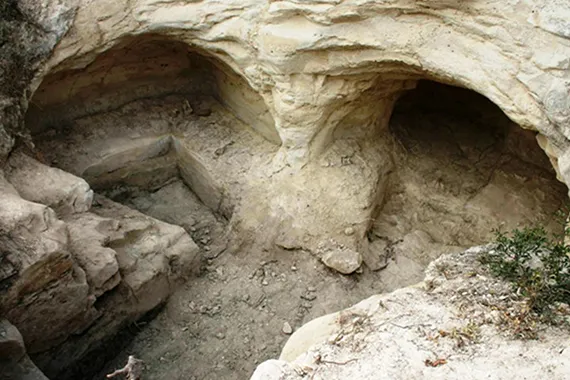
Jerusalem Cave
In 1961 two rock-hewn burial caves (65 feet apart) were discovered during road works. They were subsequently excavated and dated to the late Iron Age (ca. 600 – 700 B.C.). The layout of the southern cave, was later dubbed the “Jerusalem Cave,” because it contained the oldest known writing of “Jerusalem” in ancient Hebrew. A corridor leads into two burial chambers featuring hewn benches running along the walls where eight skeletons were found. Because the remains were seriously affected by alternating moisture and dryness, only the approximate age and sex of the skeletons could be determined. It appeared to be a family tomb ranging from 5 years to 60 years in age at the time of death. On or near the skeletons were found a bronze earring, a bronze ring, and a bronze clasp. No pottery was found in the burial chamber. However, fragments of a large vessel that held liquids and a complete juglet which generally held precious oil or perfume were found near the cave entrance. The pottery was dated to the early Persian Period (537-332 B.C.), much later than the inscriptions in the burial cave.
What distinguishes the Jerusalem Cave are the drawings and inscriptions found on its walls. In addition to two boats, other drawings found are believed to be a person playing an ancient musical instrument (lyre or harp); a person with outstretched arms praying; and a person dressed in priestly robes wearing a headdress (a “Mitre”) or a crown. The Mitre or crown worn by priests was inscribed with “Holiness to the Lord” in pure gold. The inscriptions of the boats on the wall remained a mystery to archaeologists. It is believed that they may relate to religious beliefs.
The most important discoveries were the inscriptions of writings on the walls dating between 600 – 700 B.C. Frank Moore Cross, Jr. (1921-2012), a renowned epigraphist from Harvard University, translated the inscriptions as follows:
“I am Yahweh thy God I will accept the cities of Judah And will redeem Jerusalem.”
This was followed by a plea:
“Absolve (us) O merciful God Absolve (us) O Yahweh Deliver (us).”
An educated man of spiritual enlightenment undoubtedly made the inscriptions in the cave as one speaking as God, on behalf of God, and to God. The ability to read and write was not common among the people around 600 B.C., neither was it permissible, except for a Prophet or High Priest, to write for and on behalf of God himself. Israeli archaeologist, Joseph Naveh, supported the notion that the writings were the work of a holy man “with a fairly good handwriting.” In 1980, Patrick D. Miller, Jr., then a Professor of Old Testament Theology at Union Theological Seminary and a Harvard Professor, reviewed the inscriptions in detail and concluded: “The language is reminiscent of Jeremiah and Isaiah.”
Video
Video Transcript
While paving a road for the military in 1962 (editor’s note: 1961) a shovel dozer hit the roof of the Jerusalem Cave. It would become one of the most important burial caves ever found from the Iron Age II in the Land of Israel. Right now I’m standing inside the burial cave itself. After the shovel dozer hit, the entire ceiling of the cave collapsed. On the left you can see the benches where three complete skeletons were found intact on the burial shelves. On the walls, seven ancient Hebrew inscriptions were inscribed. One of them is the most important ancient Hebrew inscription that mentioned for the first time the exact name of God and the city of Jerusalem. While the first inscription is a prayer, the second inscription is a plea: “I am Jehovah thy Lord. I shall accept the cities of Judah and I will redeem Jerusalem. Absolve us, oh Jehovah.” Inside the burial cave, some graffiti was found. One of them is of a person playing a lyre. The second one is a holy man lifting his arms and praying to God. The third figure is of the high priest praying as well. The ancient Hebrew inscriptions and graffiti were removed by the Israel Antiquities Authority and placed in the Israel Museum for safety.
Virtual Tour
The virtual tour for this location works on your computer web browser as well as a tablet or a phone. Best of all, it works on your headset. For instructions using an Oculus Quest, please see our virtual visit page.
Image Gallery


